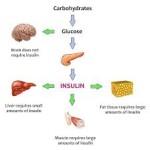 The risk of developing heart disease and diabetes are significantly increased when your cholesterol and triglyceride levels are elevated. So understanding your cholesterol and triglyceride numbers are important in your fight to live a long and healthy life.
The risk of developing heart disease and diabetes are significantly increased when your cholesterol and triglyceride levels are elevated. So understanding your cholesterol and triglyceride numbers are important in your fight to live a long and healthy life.
To understand your cholesterol and triglyceride values you must have access to your blood test results. You can receive those at the doctors office by signing a release and requesting a copy. Your blood results will show you cholesterol and triglyceride numbers that are broken down into different values. It is important that when you had your blood test done that you were fasting or had nothing to eat or drink for 8-12 hours before the test – depending upon the lab.
 But what is it they are measuring? Cholesterol is a fat like substance in our blood system. Our bodies actually manufacture all the cholesterol that we need to maintain our cell membranes, produce sex hormones, produce bile and assist in the production of Vitamin D. Unfortunately, there are substances in meat and processed foods that will break down into cholesterol in our bodies and thus give us much more than is needed. High levels of cholesterol and triglycerides have been linked to heart disease, peripheral vascular disease, stroke and pancreatitis.
But what is it they are measuring? Cholesterol is a fat like substance in our blood system. Our bodies actually manufacture all the cholesterol that we need to maintain our cell membranes, produce sex hormones, produce bile and assist in the production of Vitamin D. Unfortunately, there are substances in meat and processed foods that will break down into cholesterol in our bodies and thus give us much more than is needed. High levels of cholesterol and triglycerides have been linked to heart disease, peripheral vascular disease, stroke and pancreatitis.
Your doctor will account for your age, family history, smoking history and high blood pressure when they evaluate your cholesterol test results. The test results will have the Total Cholesterol, low density lipoproteins (LDL), high density lipoproteins (HDL) and triglycerides.
When you evaluate your blood test to understand your cholesterol and triglyceride levels you will look first at your total cholesterol number. This number is best under 200. At a level between 200 and 239 doctors will consider this a borderline-high risk level for heart disease, stroke and diabetes. Your physician will compare your total number against the LDL, HDL and triglycerides, as well as against other risk factors for heart disease and stroke that you may have. At this level, you will need to work with your doctor to create a prevention program that includes dietary changes, weight loss and exercise.
Resources:
American Heart Association: What Your Cholesterol Levels Mean
American Heart Association: Good vs. Bad Cholesterol
American Heart Association: Understanding and Managing Your Triglycerides
http://www.acponline.org/patients_families/pdfs/health/tri.pdf
MedlinePlus: Understanding Cholesterol Results
http://www.nlm.nih.gov/medlineplus/ency/patientinstructions/000386.htm
MayoClinic: Cholesterol Test
http://www.mayoclinic.com/health/cholesterol-test/MY00500/DSECTION=results
MayoClinic: High Cholesterol
http://www.mayoclinic.com/health/cholesterol-levels/CL00001
Sutter Health: Understaning Cholesterol
http://www.cpmc.org/learning/documents/cholesterol-ws.html
BCBS Nebraska: Managing Cholesterol
http://wellness.unl.edu/wellness_documents/managing_cholesterol.pdf
Harvard Health Publication: Understanding Cholesterol
http://www.health.harvard.edu/newsweek/Understanding_Cholesterol.htm
Marks Daily Apple: How to Interpret Cholesterol Test Results
http://www.marksdailyapple.com/how-to-interpret-cholesterol-test-results/#axzz2oYBAiG5A



Leave a Reply